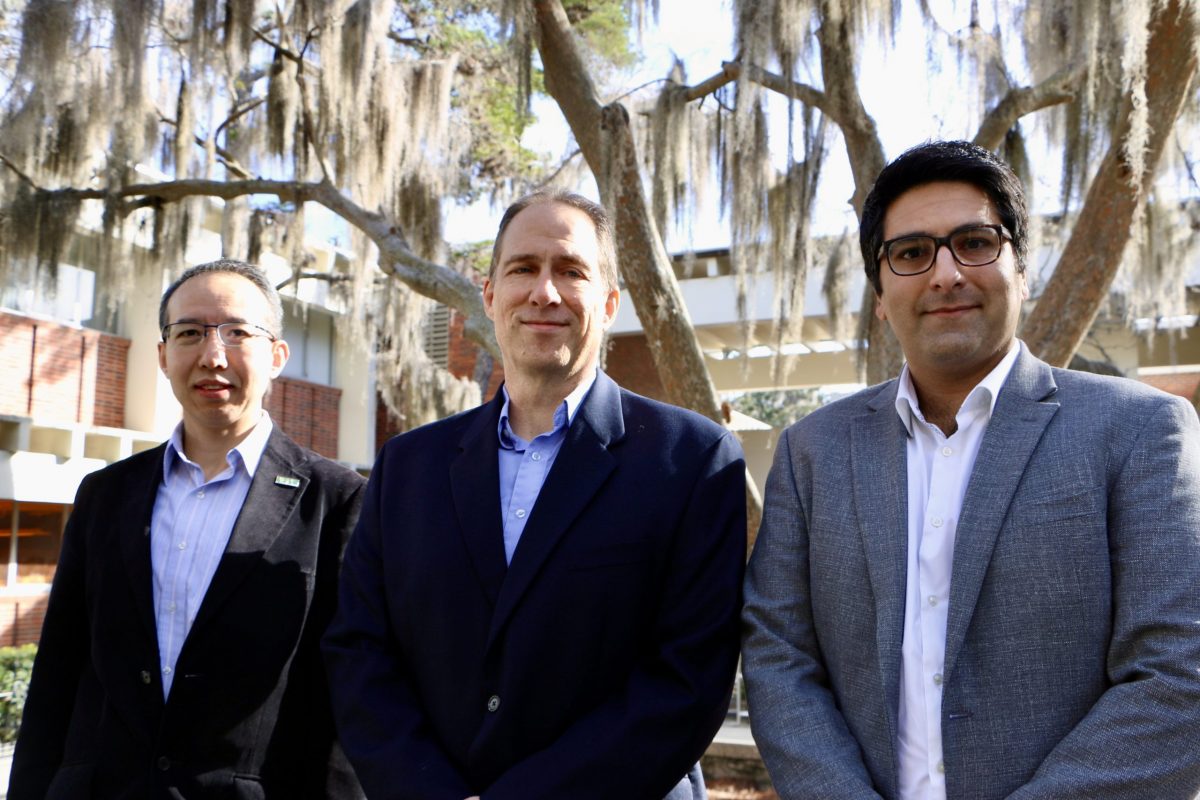Photo from left: Dr. Philip Feng, Dr. Mark Sheplak, Dr. Roozbeh Tabrizian
A diverse team led by three ECE Florida faculty members is set to receive funding from the Defense Advanced Research Projects Agency (DARPA) to design and fabricate dynamic pressure sensors capable of performing at temperatures upwards of 800 °C (1472 °F), over a factor of 6X higher than any integrated pressure sensor currently in use. The $6.6M project, funded as part of the DARPA High Operational Temperature Sensors (HOTS) program, seeks to enable all manners of electronics and sensors that would be integral to industrial, military, and space applications. The core team is comprised of Dr. Mark Sheplak (lead PI), Dr. Roozbeh Tabrizian, and Dr. Philip Feng.
THE NEED
Most sensors and electronic devices are designed to perform up to a temperature of 125ºC. In a variety of situations (think hypersonic air vehicles, inside combustion chambers, on the surface of other planets), it would be helpful to be able to measure the fluctuating pressure on a particular surface in an extreme environment. Currently, no sensors can take the heat. The HOTS program challenged researchers to create devices not only capable of withstanding such temperatures but also delivering reliable operations up to a million times every second thus requiring a sensor bandwidth of 1MHz.
From the DARPA program description:
“…the capabilities of sensors can be inhibited by thermal limitations. A sensor may theoretically be able to process inputs such as speed, pressure, or the integrity of a mechanical component, but inside a turbine engine, temperatures far exceed what any existing sensor can withstand. However, if we can design, integrate, and demonstrate high-performance physical sensors that can operate in high-temperature environments, we can advance toward systems that perform at the edge of their capability instead of the limits of uncertainty.”
The technical problems in extreme-temperature pressure sensing have persisted since at least the beginning of hypersonics research in the late 1946, when the term was coined by Cal Tech aerodynamicist Hsue-Shen Tsien. When Sheplak began his dissertation work in the early 1990s at NASA-Langley Research Center in the area of instrumentation development for hypersonic turbulent boundary layer measurements, it was still an open problem. It’s only relatively recently, with advances in materials science, high-bandgap semiconductor circuit design, and MEMS technologies, that the fundamental problems can be tackled in earnest.
The team’s platform, Integrated Harsh-Environment Analog Transducers (iHEAT), harnesses decades of collective experience in areas as diverse as aerodynamic sensor design, thin-film piezoelectric transducer development, and high-temperature physics.
THE TEAM
Besides the core team of Sheplak, Tabrizian, and Feng, the project brings in the expertise of two close collaborators from outside UF.
Dr. Philip Neudeck is a leading expert and authority in silicon carbide (SiC) electronics for extreme environments; his team at NASA Glenn Research Center (GRC) has repeatedly broken world records of high temperature and durability of SiC integrated circuits for Venus probes and other applications. Sheplak’s various projects with NASA in recent decades included collaborations with GRC. Dr. Feng also collaborated with NASA GRC and Neudeck on integrating high-temperature-durable SiC NEMS with electronics, through the DARPA NEMS program and other DoD projects, while he was on the faculty at Case Western Reserve University.
Also on the team is Dr. Benoit Hamelin, Director of Microsystems at EngeniusMicro, an expert in SiC MEMS development. Prior to EngeniusMicro, Dr. Hamelin was staffed on the DARPA PRIGM:AIMS and DARPA MRIG projects at the Integrated MEMS Laboratory at Georgia Tech. Dr. Hamelin and Dr. Feng have co-organized, over the years, the SiC+X Materials & Devices Workshop, a well-regarded workshop in the space.
The intellectual and experiential diversity of the team is certainly its strength when applied to this most difficult of engineering problems. Sheplak notes, “Philip’s Ph.D. study was done in electrical engineering and physics, Roozbeh’s was in electrical engineering, and mine was in mechanical engineering. It’s an organic thing, where faculty come together because they realize it’s useful to work in multidisciplinary teams with overlap but also with very complementary technical abilities. No one person could do this. In our studies and our earlier work, we never thought we’d end up working on a project like this, but our skillsets and prior funding and research efforts have all built toward this crescendo where we can tackle such a DARPA challenge. This is one of the major benefits of being part of the Interdisciplinary Microsystems Group (IMG)—intellectually we possess a very broad skill set.”
THE PROJECT
As is common with projects funded by government or military entities, researchers must meet or exceed specific milestones to progress to the next funding phase. For DARPA HOTS, the team has fifteen months to build and test the dynamic pressure sensor that is capable of functioning for one hour at 800˚C, demonstrating a bandwidth of 1MHz and a minimum detectable pressure of 1 Pa. During the first stage, the UF iHEAT team only focuses on the sensor—the electronics to be integrated later are designed and tested by NASA Glenn in Cleveland, Ohio, but with the same stringent temperature performance requirements.
If the iHEAT sensor performs as required, the next milestone is at 36 months from inception—full integration of the sensor and the electronics. Is the team confident of hitting the milestones? Says Sheplak, “We can do this. The collective expertise and knowledge from three of us at UF, the NASA Glenn group (led by Philip Neudeck), and the EngeniusMicro (led by Benoit Hamelin), uniquely position our team for success.”
THE FUTURE
The team’s vision for future work is similarly confident. According to Dr. Tabrizian, the nexus of the world-class facilities at UF (most notably the Nanoscale Research Facility), recent investments in equipment by the Herbert Wertheim College of Engineering, and innovations in the materials space (such as work being done by IMG) will enable UF to begin to form a sort of hub of activity in the harsh environment engineering space. UF, and the state of Florida, have the unique tools, collaborative capabilities, and the industry connections (L3Harris, NASA) to become leaders in the burgeoning area. As a return to the Moon and further exploration of Venus loom on the horizon, UF is well-positioned to provide the sensors and electronics that will empower the vehicles in future missions at extreme environments.
For a detailed history of hypersonics, see Facing the Heat Barrier: A History of Hypersonics.
Originally posted on ECE News.

